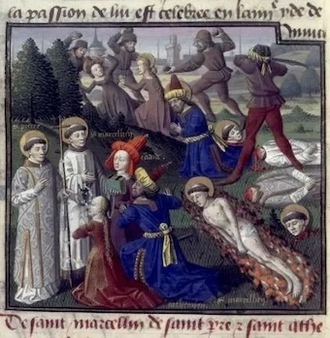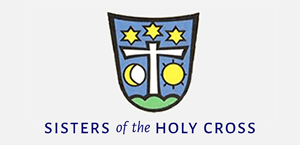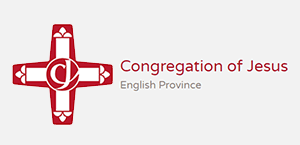Gospel in Art: Saints Marcellinus and Peter, Martyrs

Artemius, Candida, and Paulina in front of Saints Marcellinus and Peter, from the Speculum Maius by Vincent of Beauvais, 13th century © Alamy
Gospel of 2 June 2025
John 16:29-33
At that time: The disciples said to Jesus, 'Ah, now you are speaking plainly and not using figurative speech! Now we know that you know all things and do not need anyone to question you; this is why we believe that you came from God.' Jesus answered them, 'Do you now believe? Behold, the hour is coming, indeed it has come, when you will be scattered, each to his own home, and will leave me alone. Yet I am not alone, for the Father is with me. I have said these things to you, that in me you may have peace. In the world you will have tribulation, but take heart: I have overcome the world.'
Reflection on our Illuminated Manuscript Illustration
Saints Marcellinus and Peter were two early Christian martyrs who are honoured in the Roman Canon (Eucharistic Prayer I), where they are named among the first saints of the Church. We are probably most familiar with them through this Eucharistic prayer when they are mentioned. According to tradition, Marcellinus was a priest and Peter an exorcist, both serving in Rome during the persecution under Emperor Diocletian at the beginning of the 4th century. Their story was later recorded by Pope Damasus I, who claimed he had heard the account directly from their executioner after his conversion. The two saints were arrested for their faith and imprisoned. While in prison, Peter is said to have exorcised the daughter of his jailer, leading to the conversion of the jailer's entire household. For this, Marcellinus and Peter were condemned to death. They were taken to a remote forest outside Rome and beheaded in secret, so that no Christians would be able to venerate their burial place.
However, their memory could not be erased. Their bodies were eventually discovered and reinterred by a Christian matron named Lucilla, who provided a proper burial in the catacombs on the Via Labicana. A basilica was later built on the site by Emperor Constantine, honouring their sacrifice and witness. Their names have been preserved in the Roman Canon since the 4th century, serving as a reminder of the courage of those early martyrs who gave their lives in the face of imperial violence. They are often invoked as intercessors for steadfastness in faith and fidelity in the face of adversity.
Our illuminated manuscript illustration comes from the Speculum Maius (The Greater Mirror), one of the most ambitious encyclopaedias of the Middle Ages, compiled by Vincent of Beauvais (c. 1184-1264), a Dominican friar and royal librarian to King Louis IX of France. Written in Latin in the 13th century, it was conceived as a mirror of the world, reflecting the entirety of human and divine knowledge within a Christian framework. The title "Mirror" (Speculum) was intentional: in medieval thought, a book could serve as a mirror to help the reader contemplate the order of nature, the structure of human knowledge, and the unfolding of salvation history.
Originally composed of three parts, the Speculum Maius included the Speculum Naturale (Mirror of Nature), dealing with theology, the natural world, and creation; the Speculum Doctrinale (Mirror of Doctrine), covering human learning such as grammar, logic, ethics, and the mechanical arts; and the Speculum Historiale (Mirror of History), a universal chronicle from Creation to Vincent's own time. A fourth part, the Speculum Morale (Mirror of Morals), was later added but likely not written by Vincent himself. Our illustration features in the latter part, as an example of saints leading a deeply moral and courageous life.
LINKS
Gospel in Art: https://christian.art/
Today's Reflection: https://christian.art/daily-gospel-reading/john-16-29-33-2025/ (with audio)


















